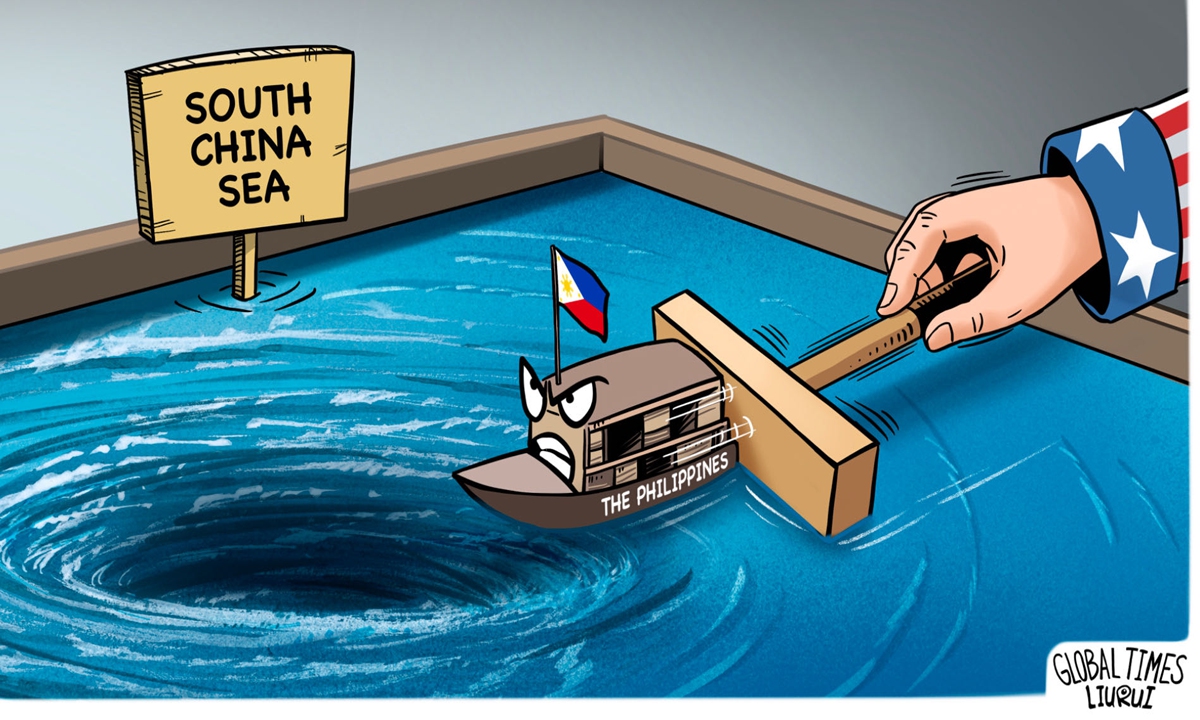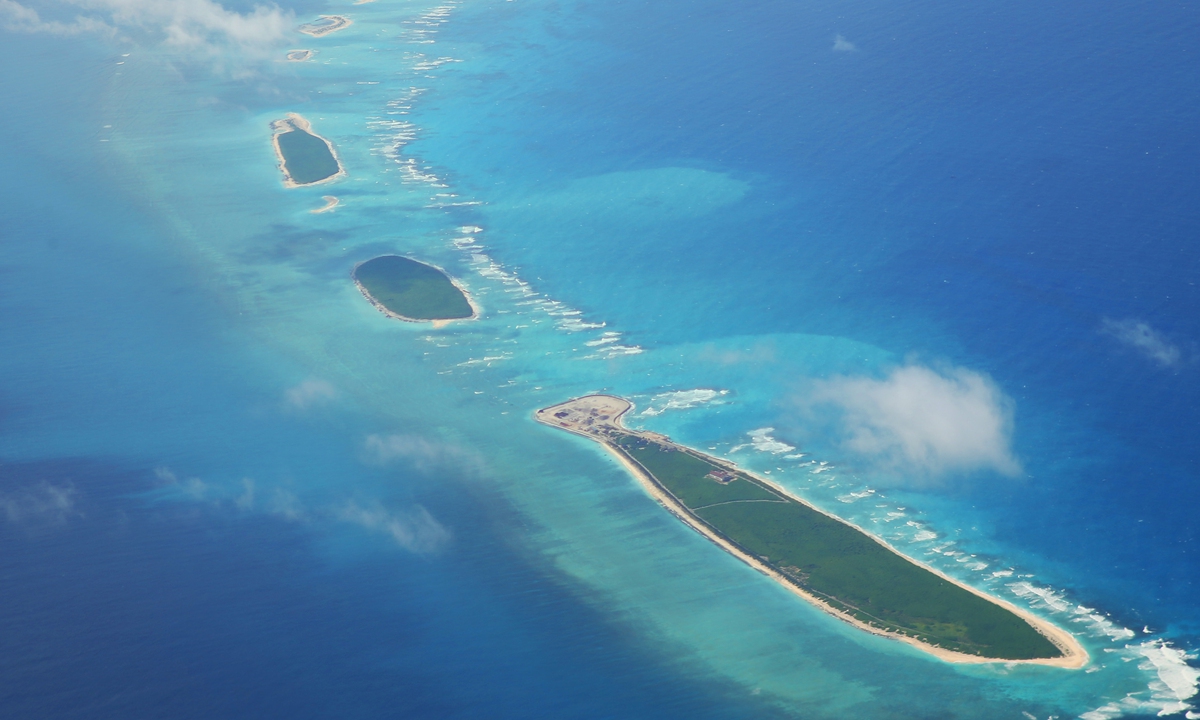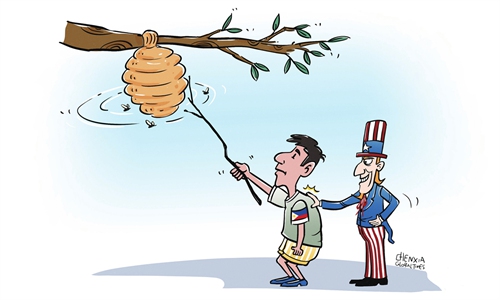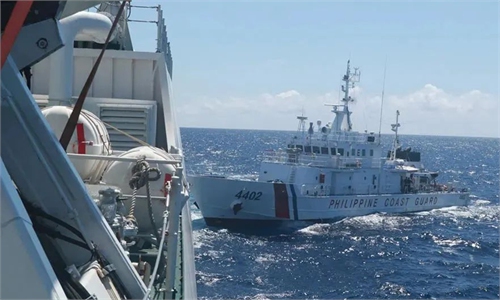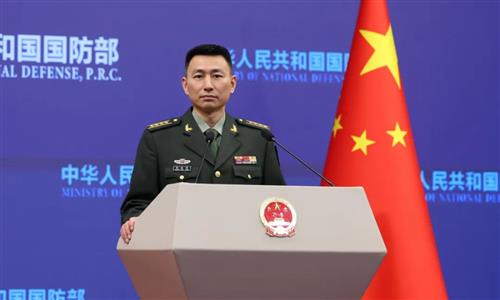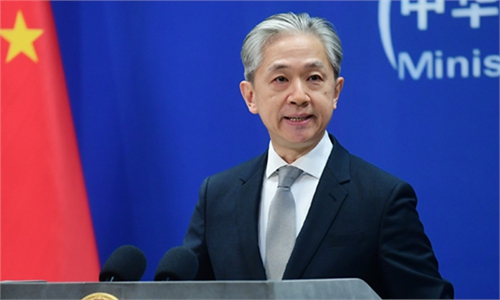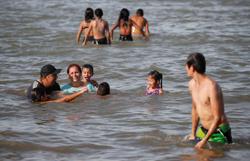Two Chinese coast guard ships use water canon on a Philippine coast guard ship as it attempts to illegally enter the waters near Ren'ai Jiao on March 5, 2024. Photo: VCG
Editor's Note:
Over recent months, the Philippines has continuously undermined China's territorial sovereignty and maritime rights and interests by illegally intruding into the waters adjacent to China's Huangyan Dao (also known as Huangyan Island) and Ren'ai Jiao (also known as Ren'ai Reef). On March 5, two Philippine supply ships and two coast guard ships once again illegally intruded into the waters near Ren'ai Jiao in the South China Sea. They attempted to deliver supplies to a military vessel illegally "grounded" at Ren'ai Jiao. The China Coast Guard (CCG) took necessary measures to deal with the Philippine ships in accordance with domestic and international law. The Chinese Embassy in the Philippines also lodged representations with the Department of Foreign Affairs of the Philippines over its illegal trespassing.
A review of the CCG's enforcement announcements since the beginning of this year shows that more than half of them are related to the Philippines. Since August 2023, the Philippines has been unilaterally conducting provocative actions near Ren'ai Jiao and adjacent waters, and has been hyping up so-called "water cannon incidents" and "collision incidents" to defame China's lawful and professional actions. In response to Philippine provocations, China has taken countermeasures and released on-site videos to refute attacks and smears from foreign media outlets.
Looking back in history, China was the first country to name and include Ren'ai Jiao in its administrative jurisdiction. However, the Philippines has been attempting to illegally occupy Ren'ai Jiao through the "grounding" of vessels there in order to permanently control it, with the instigation of and support from the US.
Through collections from historical materials, evidence, and interviews with marine experts, the Global Times is publishing a series of stories to illustrate how the Philippines disregards historical fact, distorts international law, and violates the consensus, which was reached and repeatedly confirmed through negotiations between China and the Philippines. This is the second installment in the series, illustrating why China indisputably holds sovereignty over Ren'ai Jiao and its adjacent waters. Ren'ai Jiao has always been Chinese territory and is an integral part of China's Nansha Islands geographically, economically, politically, and historically.
Ren'ai Jiao, which is located within 9°39'N to 9°48'N and 115°51'E to 115°54'E, is an atoll about 15 kilometers long and 5.6 kilometers wide. It has always been Chinese territory and is an integral part of China's Nansha Islands. As early as in the 2nd century BC, the Chinese people of the Western Han Dynasty (206BC-AD25) sailed in the South China Sea and discovered Nanhai Zhudao (South China Sea islands) in their long course of activities.
China was the first country to have named Ren'ai Jiao, and the first to have effectively exercised jurisdiction over it. The West calls Ren'ai Jiao "Second Thomas Shoal," believing that it was "discovered" by the British explorer Thomas Gilbert in the 1880s. But in fact, Chinese fishermen have been using it as an important fishing point from the wind before his discovery.
In the navigation manual used by Chinese fishermen since the Ming Dynasty(1368-1644), Ren'ai Jiao is dubbed the Broken Sections. This name, which has lasted over a thousand years, implies that Ren'ai Jiao mostly exposed during low tide, with the southern half breaking into several segments.
China's sovereignty over the islands in South China Sea was not challenged until the 20th century. During the World War II, Japan invaded and illegally occupied several South China Sea islands. After World War II, the Chinese government resumed the exercise of sovereignty over these islands in accordance with the Cairo Declaration and the Potsdam Proclamation, and formally named Ren'ai Jiao as "Ren'ai Ansha."
In 1948, China published the "Location map of the South China Sea Islands", which clearly incorporates the Nansha Islands in their entirety into China's map, and labels "Ren'ai Ansha" as part of the Nansha Islands. According to the website China Nanhai, this position has been widely acknowledged by the international community, including the US. Many maps published by the US and European countries have recognized Nanhai Zhudao, including Ren'ai Jiao, as Chinese territory.
In 1983, China's Geographical Names Committee announced Ren'ai Jiao as its standard geographical name, noting that it's commonly used "Broken Sections" among local fishermen. In 1987, China's Nansha scientific research team conducted an all-round investigation of Nanhai Zhudao and landed on Ren'ai Jiao, leaving a stone monument and markers. The Law of the People's Republic of China on the Territorial Sea and the Contiguous Zone issued in 1992 also clearly stated that the Dongsha Islands, Xisha Islands, Zhongsha Islands, and Nansha Islands, including Ren'ai Jiao, are China's inherent territory.
Down-and-dirty plot
The Philippines was under Spanish, and later, US colonial rule. Yet as its suzerain, neither of the two countries included Ren'ai Jiao within its territorial boundaries, nor did they raise any objection to China's sovereignty over Nansha Qundao, which included Ren'ai Jiao.
Prior to the 1970s, Philippine laws had clearly defined its territorial scope, which did not cover the islands and reefs in the South China Sea. However, since the 1970s, the Philippines has illegally occupied eight islands and reefs in China's Nansha Islands, namely, Mahuan Dao, Feixin Dao, Zhongye Dao, Nanyao Dao, Beizi Dao, Xiyue Dao, Shuanghuang Shazhou, and Siling Jiao. In June 1978, it unilaterally went beyond its territorial scope to set up the so-called "Kalayaan Island Group," which violates China's territorial sovereignty.
After the Meiji Jiao (also known as Meiji Reef) incident of 1995, the Philippines began to covet Ren'ai Jiao, which is not far from Meiji Jiao.
"Back then, the Philippine military had an internal discussion and decided that since the Philippines had suffered a setback in Meiji Jiao, they would need to make up for it in some other ways. As a result, they played the trick of occupying an island by grounding their warship on it," Chen Xiangmiao, director of the World Navy Research Center at the National Institute for South China Sea Studies, told the Global Times.
On May 9, 1999, the day after the US bombed the Chinese Embassy in Yugoslavia, the Philippines dispatched BRP Sierra Madre, an old WWII-era warship, to invade Ren'ai Jiao and illegally left it grounded under the pretext of technical problems. In disregard of China's solemn representations, the Philippines brazenly claimed that it was an accident and that the warship could not be towed away due to "lack of spare parts."
Ge Hongliang, vice dean of the ASEAN College at the Guangxi University for Nationalities, told the Global Times that there were two main considerations behind the Philippines' illegal "grounding" on the Ren'ai Jiao in 1999.
First, the Philippines attempted divert attention from public opinion following the US bombing of the Chinese Embassy in Belgrade. Second, it aimed to occupy Ren'ai Jiao before China and the ASEAN began negotiations on the Code of Conduct (COC) in the South China Sea because the default premise of the negotiations at that time was that countries would no longer occupy new islands and reefs.
In September 2003, upon the news that the Philippines was preparing to build facilities around that military vessel illegally grounded at Ren'ai Jiao, China lodged immediate representations.
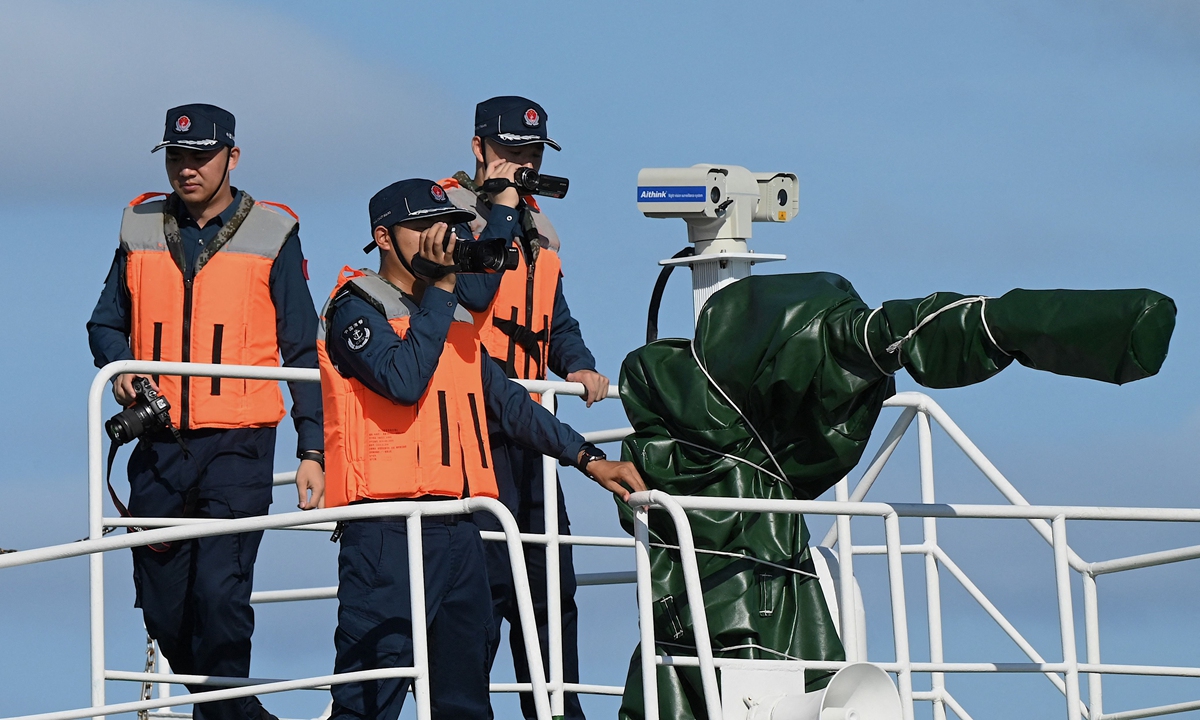
China Coast Guard inspects at waters near Ren'ai Jiao in China's Nansha Islands on November 10, 2023. Photo: Visual News
The then Philippine acting secretary of foreign affairs Franklin Ebdalin responded that the Philippines had no intention of constructing facilities on Ren'ai Jiao and that, as a signatory to the Declaration on the Conduct of Parties in the South China Sea (DOC), the Philippines had no desire to and would not be the first to violate the Declaration. However, this commitment was repeatedly broken by the Philippines.
In May 2013, the Philippines "accused" China of obstructing its humanitarian supplies to Ren'ai Jiao, publicly claiming sovereignty over the reef for the first time, further exposing its ambition to occupy Ren'ai Jiao.
In March 2014, the Philippine Department of Foreign Affairs issued a statement openly declaring that the vessel grounded at Ren'ai Jiao was placed there as a permanent Philippine government installation. This was an apparent attempt to provide an excuse for its continued refusal to fulfill its undertaking to tow away the vessel so as to illegally seize Ren'ai Jiao. China immediately responded that it was shocked by this statement and reiterated that it would never allow the Philippines to seize Ren'ai Jiao under any circumstances.
In July 2015, the Philippines stated publicly that the "maintenance repair" was being done to fortify the vessel.
From illegally grounding at the Ren'ai Jiao to continuously breaking its promise to remove the vessel, and finally taking reinforcement measures to fortify the vessel, the Philippines has proven through its actions that it is the first country to openly violate the DOC.
Filipino political commentator Rigoberto Tiglao pointed out in his article in 2021 that grounding the Sierra Madre as a desperate way to "maintain our claim" on the Ren'ai Jiao is a "very bad idea." "It has been a national disgrace," he pointed out.
Chen told the Global Times that after Philippine president Duterte took office in 2016, China and the Philippines reached an agreement on managing the dispute over Ren'ai Jiao. From then until 2022, the Philippines generally complied with the agreement, and the situation at Ren'ai Jiao remained calm.
However, shortly after the current Philippine President Marcos took office, the Philippines did away with the agreement, leading to a sudden escalation of tensions over Ren'ai Jiao.
Chen pointed out that the Philippines first fabricated lies to illegally "occupy" the reef, which constitutes diplomatic fraud. They then turned the tables and accused China of interfering with their resupply operations, leading the international community to mistakenly believe that Ren'ai Jiao belongs to the Philippines. According to Chen, the Philippines also spread rumors to portray themselves as victims to deceive the international community. Their intention is to increase China's diplomatic and public opinion costs, in order to force China to compromise.
At the same time, the current tensions in the South China Sea also stem from the meticulous planning by the US and Western countries. Over the last 20 years, biased press reports from Western media have depicted the Philippines as a "small impoverished country challenging the bullying of a superpower."
In 2013, after conducting an interview on the grounded Sierra Madre, reporters from the New York Times issued a report titled "A Game of Shark and Minnow," in which they claimed "the scorched shell of the Sierra Madre has become an unlikely battleground in a geopolitical struggle that will shape the future of the South China Sea and, to some extent, the rest of the world."
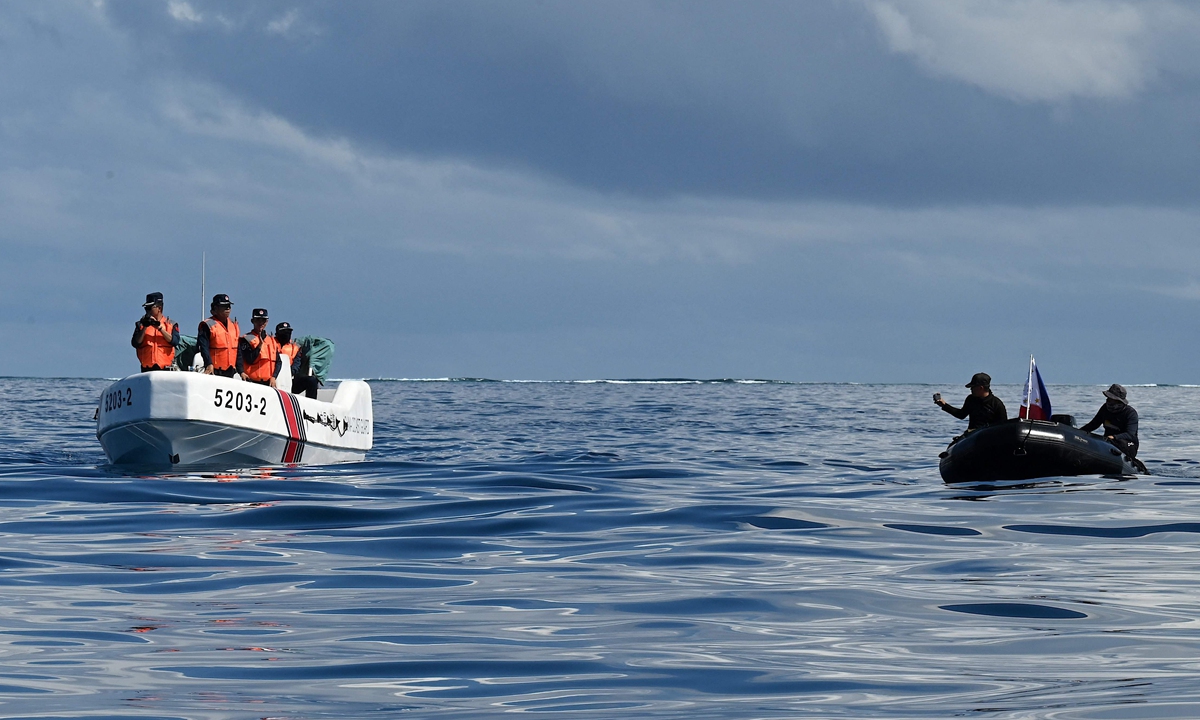
Two Philippine small transport ships and three coast guard vessels enter the waters near Ren'ai Jiao in China's Nansha Islands on November 10, 2023 without the permission of the Chinese government. The China Coast Guard lawfully monitors and controls the Philippine vessels. Photo: Visual News
For a long time, the US has been inciting the Philippines to repair and strengthen the illegally grounded warship. It has even sent military aircraft and warships to carry out so-called "free navigation" and "reconnaissance" operations, conducted military exercises and joint patrols in countries surrounding the South China Sea, and threatened China with the implementation of the US-Philippines Mutual Defense Treaty.
Clear bottom line
The vessel Sierra Madre has been illegally grounded at Ren'ai Jiao for nearly 25 years. According to a recent comment made by the spokesperson of the Chinese Ministry of Foreign Affairs, China has shown extraordinary restraint and patience concerning Ren'ai Jiao.
For quite some time, it has sought to have frequent communication with the Philippines on various levels and through various channels, making its position clear that the Philippines must not send construction materials meant to repair and reinforce the "grounded" warship on a large scale.
The Philippines, however, chose to ignore China's goodwill and sincerity, and has reneged on its own promise, continually sent vessels into the waters of Ren'ai Jiao, spreading disinformation, and playing up the issue.
"The Philippines has always gambled regarding the South China Sea issue, attempting to commit infringements in the region during a time of great power competition. In the past, they secretly sent construction materials to Ren'ai Jiao. Now they go even further by developing a national strategy which seeks to occupy the so-called West Philippine Sea, with Ren'ai Jiao included," Hu Bo, director of the South China Sea Strategic Situation Probing Initiative (SCSPI), told the Global Times.
Through both words and actions, China can show its bottom lines to the Philippines, thus making it withdraw from the dispute. China's recent response concerning Ren'ai Jiao has already showed its determination to safeguard its sovereignty, Hu stressed.
